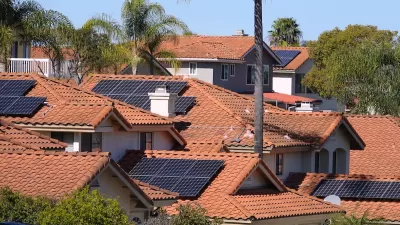What if most cars were electrics, most electricity was generated locally, and new development was required to have solar? Would this paradigm make sprawl more energy sustainable than compact growth? A new paper argues yes.
New research from "Professor Hugh Byrd (formerly with) the University of Lincoln (School of Architecture), UK, and collaborators including Professor Basil Sharp from the New Zealand Energy Centre and experts from the University of Auckland, New Zealand challenges the conventional theory that compact urban form offers the best solution for a sustainable city."
Rather than faulting the greater energy consumption associated with suburban development, the "researchers highlight the potential of suburbs for harnessing solar energy, with detached suburban houses capable of producing ten times the amount of energy created by skyscrapers and other commercial buildings."
The other aspect of energy where suburbs are faulted is their long commutes and increased local trips, but what if electricity was the predominant fuel?
While a compact city may be more efficient for internal combustion engine vehicles, a dispersed city is more efficient when distributed generation of electricity by photovoltaic installations is the main energy source and electric vehicles are the principal mode of transport.
Even in this "sprawl is good" land use scenario, city planners are needed. "If this energy contribution is to be effective, controls of new suburban development may be needed that require the installation of photovoltaic roofing, along with smart meters and appropriate charging facilities for vehicles. City planners will need to make the changes necessary to control suburban development."
The researchers see the energy potential of sprawling development as providing an energy source for center cities. From the abstract: "The purpose of this is to evaluate the contribution that electricity from PVs can make to reduce the electricity load of a city, supply the needs of a mixture of building types, reduce peak electricity demand and contribute towards the charging of electric vehicles (EVs)."
We may need some time to verify the findings. While EV sales are increasing, having "more than doubled in the U.S. during the first six months of 2013", according to AOL Autos associate editor Pete Bigelow, they "still represent only 1.23 percent of the total market". In addition, they are limited as to the range they travel, so it would seem we have a long ways to go to verify what the research shows about the energy sustainability of suburbs.
FULL STORY: Suburban Sprawl to Power Cities of the Future

Alabama: Trump Terminates Settlements for Black Communities Harmed By Raw Sewage
Trump deemed the landmark civil rights agreement “illegal DEI and environmental justice policy.”

Planetizen Federal Action Tracker
A weekly monitor of how Trump’s orders and actions are impacting planners and planning in America.

The 120 Year Old Tiny Home Villages That Sheltered San Francisco’s Earthquake Refugees
More than a century ago, San Francisco mobilized to house thousands of residents displaced by the 1906 earthquake. Could their strategy offer a model for the present?

Ken Jennings Launches Transit Web Series
The Jeopardy champ wants you to ride public transit.

BLM To Rescind Public Lands Rule
The change will downgrade conservation, once again putting federal land at risk for mining and other extractive uses.

Indy Neighborhood Group Builds Temporary Multi-Use Path
Community members, aided in part by funding from the city, repurposed a vehicle lane to create a protected bike and pedestrian path for the summer season.
Urban Design for Planners 1: Software Tools
This six-course series explores essential urban design concepts using open source software and equips planners with the tools they need to participate fully in the urban design process.
Planning for Universal Design
Learn the tools for implementing Universal Design in planning regulations.
Clanton & Associates, Inc.
Jessamine County Fiscal Court
Institute for Housing and Urban Development Studies (IHS)
City of Grandview
Harvard GSD Executive Education
Toledo-Lucas County Plan Commissions
Salt Lake City
NYU Wagner Graduate School of Public Service




























